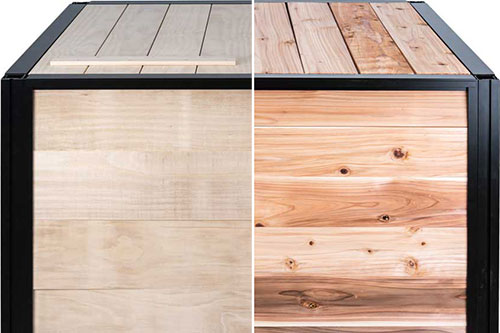Choosing wood for composter slats
The choice of material for the sides and possibly the lid of your composter is a very important decision. And, of course, although we have had good experiences with other materials like composites, most of you will want to use wood. If you want to use wood then, regardless of whether you are making your own composter or sourcing your own timber for your CarbonCycle Composter, finding the right wood is essential to having a long-lasting and well-functioning composter.

Why use wood for your composter slats?
You may have noticed that many composters are made completely out of wood. Whilst we have struggled with wooden frames because they tend to buckle or have other shortcomings, the CarbonCycle Composter is ideal for use with wooden side and lid slats. So what is it about wood that makes it so popular for composter slats?
- Wood is a natural, renewable product so its carbon footprint is low. Because of the many different types of wood and their functionalities, it is easy to find one that suits our purposes for a composter.
- It is easy to find durable types of wood that can last for years. However unlike plastic and metal, wood does break down eventually, and when it does, it can join your compost pile and become part of the carbon cycle.
- Many types of wood are highly heat resistant which makes them ideal to border a hot composter.
- Wood also has the benefit of being customisable. You can choose which style of wood works for you, and you can change its appearance to make it work for whatever you need. Wood can be dressed, painted, stained, or polished to suit the aesthetic of your garden. However, rougher or lower quality timber may have less attractive results. Please follow all instructions relevant to the timber used in your slats.
Types of wood to use for a composter
There are many options for wood to use for your composter. The options can be overwhelming, so let’s look at what they are and what they mean.
Style of wood
Firstly, the style of wood that we recommend for a composter’s sides and lids are timber (aka lumber) slats. These are thin sheets of wood that can be cut down to the size you need. They are flat so can easily make a square-shaped box, ideal for turning compost. If you have a CarbonCycle Composter, slats can be slid into the metal frame one-by-one and removed and replaced as needed.
Type of wood
You will also need to decide whether you would like hardwood or softwood. Hardwoods are are more durable generally but they are heavy and often non-systainable. Softwoods treated by acetylation are also likely to make long-lasting and durable slats. And many untreated softwoods do a perfectly good job, even if they may not be as durable and/or stable.
Specifically, some of the timber types we have used for our composter slats include:
- Accoya: this is a premium timber; arguably the most durable and highest quality timber that is generally available. Accoya is pine treated by a patented process that, unlike some other treatments, does not leach and has no adverse environmental impact. It guarantees a 50 year above-ground life. This may not apply under composting conditions but an extremely long life can be expected. However, it is quite heavy and costly, so some might prefer to consider other alternatives. For further information please refer to the Accoya website.
- Japanese Cedar: we have used this in many of our composters. It is relatively inexpensive and should give many years or service
- Macrocarpa: we have also used this in many of our composters. It is heavier than many other timbers but it is serviceable
- Lawson Cypress: we have used this from time to time with good results.
- Cypress Pine: This is a very sound timber available in Australia. Whilst generally supplied green it has low shrinkage and good stability. It is also naturally termite resistant.
- Golden Cypress: Used often in Australia for composters and similar uses. Generally claimed to include less sapwood than its New Zelaand brother and to be harvested from older slower-growing trees.
Dressed or rough-sawn
Finally, you can choose whether you want timber that is dressed or rough-sawn. Dressed timber has a machine finished result, meaning the surfaces are smoother, with a more polished appearance. They are also more easily painted. It is possible to buy timber that is dressed on 3 sides, which is fine for composters, as you would normally have the undressed side facing inward. Rough-sawn timber, on the other hand, has a more rugged appearance, closer to the natural look of the wood.
The CarbonCycle Company offers options for dressed and/or rough-sawn timber slats for our CarbonCycle Composters. WIth Accoya, options are instead for blanked (pre-dressed) and dressed. Our dressed slats are around 19mm (3/4″) thick, while the rough-sawn and blanked slats are around 25mm (1″) thick. Dressed slats are more costly because of their premium appearance and because of the extra labour that goes into shaping them.
What you should know when sourcing your own wood for your composter slats
There are a few things that you need to keep in mind when sourcing your own timber boards for your composter slats.
Avoid treated timber
The first thing to remember is to avoid timber that has been treated with copper, arsenic or chrome. Such treatments might place your compost at risk, especially if it will be used to grow food. But there are other treatments that are risk-free in these regards and that can be used without risk. For example, acetylated softwoods. This post has more information about the issues with treated timber.
Take notice of dimensions
The next thing is to be careful about the required dimensions. Slats have 3 dimensions: length, thickness and width. When we refer to thickness, we are referring to the thickness of a side slat when it is in position and you are looking down on it from the top. And width is the vertical height of a slat in position i.e. when you are looking at it from the side.
In our Original CarbonCycle Composter the slats need to span a vertical distance of c 977.5mm (c 38.5”). You can decide how to span that gap ie how wide each slat should be. Ideally, we suggest between 4-7 slats. The slats that we supply have a length of 1115mm and a width of between 137-193mm. This width allows for either 5 or 7 slats to fit in each side, and 7 or 8 for the top. The thickness varies depending on whether the timber is dressed or not, so it’s between 19-27mm. You can check specific dimensions for our timber slats on their product page.
Decide how much space you want between slats
You will need to determine whether you wish each slat to sit directly on top of the slat below or whether you wish to allow for a space between each slat. Gaps are traditionally recommended to allow more breathability for your compost. For what it is worth, we have tested composting both with and without such spaces and we think it makes next to no difference. Of course, if you are concerned about possible pests, you will not want to use spacers. So, too, if you are intending to use slats on your lid you will probably not want gaps there.
If you want spaces, you will need to factor the spaces into the width and therefore the number of your slats. You will also need to ensure that the slats can hold themselves up in your compost bin.
Take account of possible twisting and expansion
You should also factor in the possibility that your timber will twist or expand. Timber is inherently at risk of changing shape. It will, for example, swell if wet and shrink if dry. It can also distort over time and rot. In our experience, most slats should remain usable for many years but there is no guarantee, as it depends on the quality of the wood and the conditions in which it is kept. Hardwoods and better quality (treated) softwoods are likely to perform better over time.
There should be some extra space in your composter frame channel to allow for the expansion of the slats. We suggest allowing up to an extra 6mm (1/4″) of thickness (breadth) and up to an extra 12mm (1/2″) of length.
The channel in the Original CarbonCycle Composter Frame is c.30mm (c.1.18”) wide and the length between one end channel in one column and the opposing end in the next column is c.1130mm (c.44.5”).
Decide if you want lid slats
We recommend having a lid for your compost box. This is because a lid can trap more heat inside the box which will help your material to compost faster. A good lid will also help to keep out rain and pests. Wooden slats are effective for this purpose. The CarbonCycle Composter Lid is what we recommend, but you can source your own slats for this, too. Like the side slats, lid slats for the CarbonCycle Composter can be inserted and removed as needed.
That being said, you could also cover your compost with sacks, carpet, dry grass, or wood chip. A tarpaulin can then be used on top to keep out the rain.
How to source your own wood for your composter
Now that you have figured out how many slats you will need, their dimensions, and the type of wood you want, it is time to get your slats. Unless you choose to buy from us, you will need to contact your local timber yard or hardware store and let them know what you are after.
When you are talking to suppliers, be aware that there are many different types of wood which could be suitable for a compost box. The same timber can also have different names in different geographical regions. So keep your mind open to possible alternatives to the timber you have in mind, as your local timberyard may not supply the exact type you are after.
Do you need help getting timber slats for your compost box?
We get that it can be daunting deciding on and finding the right timber for your compost box. That’s why we offer complete timber slat solutions with the CarbonCycle Composter. But if you want to find your own timber and are struggling, get in touch. We will do our best to help.

No Comments